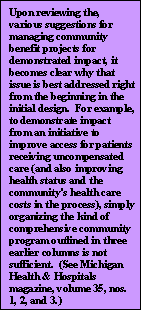As printed in Michigan Health & Hospitals Magazine, Jul/Aug 2000
THE COMMUNITY BENEFITS COLUMN
Community Benefits Impact, Part 3
BY ROBERT M. SIGMOND
This is the third column in a series devoted to measuring the impact of community benefits initiatives. The first focused on the importance of projects designed to benefit targeted communities. The second concentrated on incorporating quantitative goals as the basis for measuring impact of relevant community benefit projects.
This last column in the series will focus on incorporating an explicit methodology for evaluating whether the project is actually having impact. There are three basic elements of evaluation methodology for community benefit projects.
The first is an accountability structure that designates the individual responsible for managing the resources, manpower and relationships involved in achieving the project's goals and objectives, as well as the responsibilities of everyone involved. In almost all cases, lines of accountability are required that fall outside of the normal hierarchical structure of the organization.
 Another element is a database that involves regularly updating information from public health and other sources on community health factors, as well as information about the organizational activities required for the project to move forward and have impact.
Another element is a database that involves regularly updating information from public health and other sources on community health factors, as well as information about the organizational activities required for the project to move forward and have impact.
Annual reporting on the impact of the project, which involves much more than a report made available to the targeted community, is the last element. The annual reporting process can provide an opportunity for all those within the institution and the community who are involved to report openly on their progress in achieving their structural, process or outcome objectives; to identify obstacles still to be overcome; and to propose updated goals and objectives for the coming year. An important part of the annual reporting process is the means for public comment on the project's overall effectiveness and appropriateness.
A specific community must be targeted, preferably one small enough that the institution's initiative can be designed to make a measurable difference with available resources without overlooking any uncompensated patient. In addition, the targeted community should be one in which some staff have established relationships upon which the credibility of the institution's initiative can be built.
Beyond that, someone must be put in charge and authorized to build a committed team from various elements of the hierarchy, including clinical care, collections, social service and more. That person will also be authorized to speak on behalf of the institution in relation to many organizations in the targeted community that can help with under-served patients and their families. Equally important, the entire organization should be encouraged to buy into and contribute to achieving date-specific quantitative goals, initial changes in structure, and changes in processing patients, which all lead to an impact on outcomes in terms of health status and the bottom line.
With an information system supporting these efforts and with community participation in an annual progress-reporting process, the project can be expected to have measurable impact. The impact may not be the same as anticipated at the start of the project, but the systematic management and evaluation process should assure benefit to all.
ROBERT M. SIGMOND IS A MEMBER OF THE BOARD OF DIRECTORS FOR NORTHLAND HEALTH GROUP, SOUTH PORTLAND, MAINE, AND A SCHOLAR-IN-RESIDENCE AT THE DEPARTMENT OF HEALTH ADMINISTRATION AT TEMPLE UNIVERSITY, PHILADELPHIA. HE CAN BE REACHED AT (215) 561-5730 OR E-MAILED AT RSIGMOND@THUNDER.OCIS.TEMPLE. EDU.
07/06/2000
